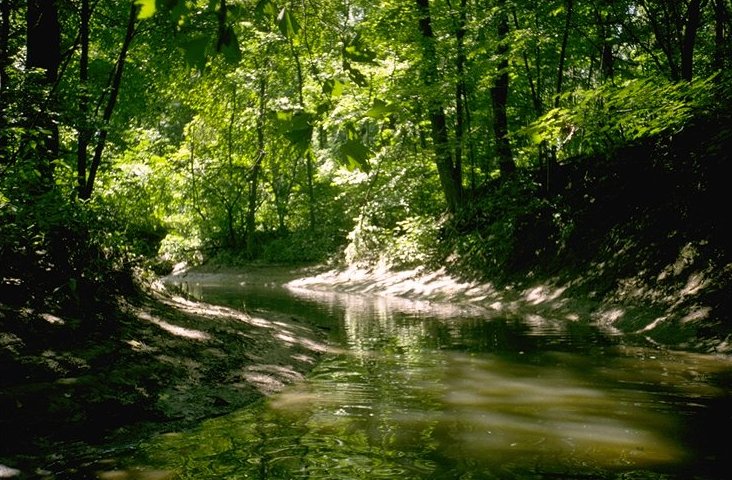What is a watershed?
Characteristics of Watersheds
 |
A watershed is an area of land that forms the drainage system for a stream or river.
This area collects surface water from land within specific topographic boundaries (such as hills, valleys, mountains, and other landscape characteristics). |
Watersheds are characterized by the location of the pour-point, or mouth, of the main flow of water to which all the other points of flow join and eventually drain from the watershed. Some of the rainfall in the area of a watershed will flow on top of the ground or find its way via underground water paths to the stream in the watershed. Some of the water will evaporate into the atmosphere, be used by people or plants, or be held in the soil or underground. Watersheds are very dynamic places becoming alternately wet and dry, due to high water and low rainfall conditions, with many differences in quality and flow depending upon the season, the year, and even with what happens during an individual storm. This is best illustrated by examining the components of the hydrologic cycle. Click here to learn more about the hydrologic cycle.
Within a watershed, activities on the land interact with the natural hydrologic cycle. Important nutrients and chemicals are circulated throughout the watershed's system and supply a basic nutritional source for both aquatic (fish, aquatic insects, etc.) and terrestrial (birds, small mammals, etc.) species. People also use these environments to grow food, build their homes and businesses, and travel from one place to another. Where and how these human activities occur have major impacts on the movement of water, water quality, and the quality of the natural habitat which remains. Ideally, we wish to have watersheds that continue to function as healthy ecosystems and serve as productive systems for people.
Many different attributes are needed to maintain a high quality, biotically rich, functioning watershed. Healthy watersheds provide stable habitats for both biological diversity and human recreational uses. These stable systems are capable of adapting to environmental changes over time and are good indicators of the quality of the surrounding habitat. The following characteristics are critical for a healthy watershed: (You can click on the pictures to see more details).
| Riparian Habitat & Protected Banks |  |
Riparian areas, areas along stream banks, are covered by transitional vegetation and act as buffers between a waterway and the surrounding area. These grasses, forbs, and trees reduce bank erosion by anchoring the soil. These buffer areas also function as a wildlife corridor and enable safer and more efficient wildlife migrations. |
| Good Water Quality |  |
Good watersheds usually function best with low turbidity, minimal suspended sediment in the water, and infrequent shifts in water levels. Frequency and intensity of fluctuating water levels are also very important considerations. |
| Adequate Shade |  |
A riparian canopy provides structure and shade, which decreases the amount of penetrable sunlight. This decrease results in less extreme temperature gradients of the surface and sub-surface water. Cooler water can hold more oxygen for aquatic species to use. |
| Meanders |  |
Meanders in a river are turns in the banks that result in a winding course for the waterway. These meanders slow the water down and allow for deposition of sediment and other suspended material on their banks. As healthy rivers and streams age, they will naturally form more meanders. |
| Biological Diversity |  |
Biodiversity is extremely valuable to both the natural order of the system and human recreation and non-consumptive uses. Different types of internal habitat and structure diversity, such as pool and riffle sequences and vegetation, also help to diversify the system and provide for increased stability. |
For more information on watersheds, visit these websites:
Adequate Shade

A riparian canopy provides structure and shade, which decreases the amount of penetrable sunlight. This decrease results in less extreme temperature gradients of the surface and sub-surface water. Cooler water can hold more oxygen for aquatic species to use.
Diversity

Biodiversity is extremely valuable to both the natural order of the system and human recreation and non-consumptive uses. Different types of internal habitat and structure diversity, such as pool and riffle sequences and vegetation, also help to diversify the system and provide for increased stability.
Good Water Quality

Good watersheds usually function best with low turbidity, minimal suspended sediment in the water, and infrequent shifts in water levels. Frequency and intensity of fluctuating water levels are also very important considerations.
Good Watershed 1

Riparian areas, areas along stream banks, are covered by transitional vegetation and act as buffers between a waterway and the surrounding area.
Meanders

Meanders in a river are turns in the banks that result in a winding course for the waterway. These meanders slow the water down and allow for deposition of sediment and other suspended material on their banks. As healthy rivers and streams age, they will naturally form more meanders.